Using eqnarray*, \phantom, and \vphantom to help with horizontal alignment and vertical sizing seemed to do the trick:
\begin{eqnarray*}
v_n(t+\tau) &=& \min\left\{v_n(t) + 2.5 a_n\tau (1-v_n(t)/V_n){(0.025+v_n(t)/V_n)}^{1/2}, \vphantom{\sqrt{b_n^2\hat{b}}} \right. \\
& & \phantom{\min}\left. b_n\tau+\sqrt{b_n^2\tau^2 -b_n [ 2[x_{n-1}(t)-s_{n-1}-x_n(t)] - v_n(t)\tau- v_{n-1}(t)^2\hat{b}]}\right\}
\end{eqnarray*}
Note that the \left\{ needs to be balanced by a \right. on the first line, and similarly for the close bracket on the second line with \left. and \right\}. The \vphantom{\sqrt...} in the first line gives the left bracket the same height as the right bracket on the second line.
Also note that I switched {min} to \min to lose the math italicization.
Here's the result from my LaTeX environment:

UPDATE
I tracked down the KaTeX online editor at https://katex.org and was able to confirm that while eqnarray doesn't work, the phantom, vphantom, and period versions of \left/right do work. Enter the following line in the Type an expression: box on the katex website to confirm the solution.
v_n(t+\tau) = {min} \left\{v_n(t) + 2.5 a_n\tau (1-v_n(t)/V_n){(0.025+v_n(t)/V_n)}^{1/2}, \vphantom{\sqrt{b_n^2\hat{b}}} \right. \\
\phantom{v_n(t+\tau) = }\left. b_n\tau+\sqrt{b_n^2\tau^2 -b_n [ 2[x_{n-1}(t)-s_{n-1}-x_n(t)] - v_n(t)\tau- v_{n-1}(t)^2\hat{b}]}\right\}
I also found on https://sixthform.info/katex/examples/demo.html that you can use a \begin{align*}/\end{align*} environment to achieve behavior similar to eqnarray*:
\begin{align*}
v_n(t+\tau) =& \min\left\{v_n(t) + 2.5 a_n\tau (1-v_n(t)/V_n){(0.025+v_n(t)/V_n)}^{1/2}, \vphantom{\sqrt{b_n^2\hat{b}}} \right. \\
& \phantom{\min}\left. b_n\tau+\sqrt{b_n^2\tau^2 -b_n [ 2[x_{n-1}(t)-s_{n-1}-x_n(t)] - v_n(t)\tau- v_{n-1}(t)^2\hat{b}]}\right\}
\end{align*}
I personally prefer this solution since it allows indentation for readability on the second line, matches the sizes of the brackets to the size of the boxes being enclosed, and maximizes similarity to the pure LaTeX solution (in case portability might be a future concern).




